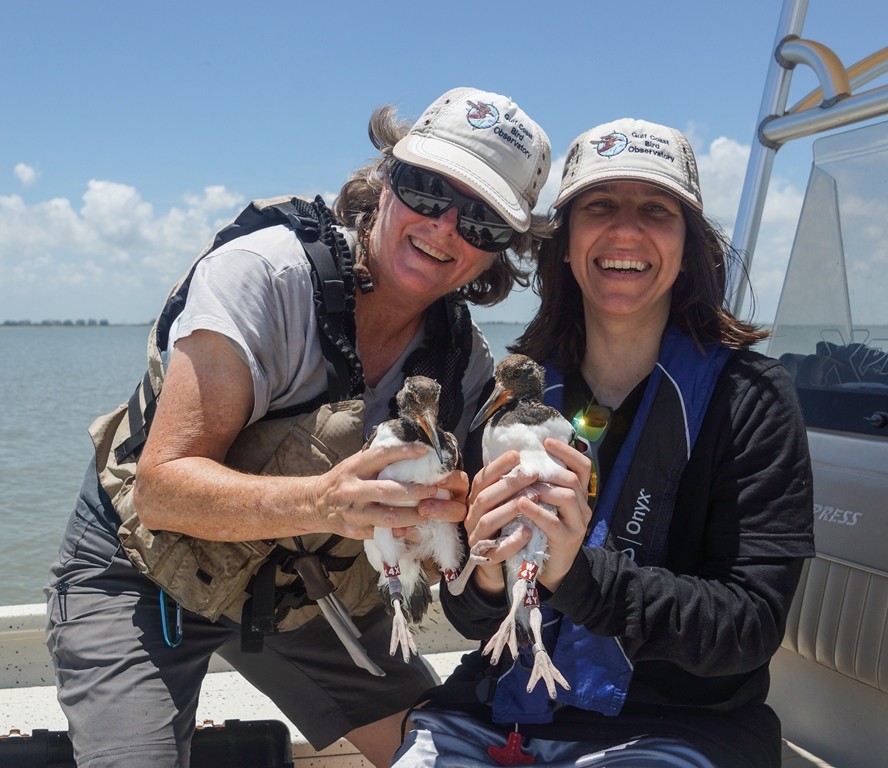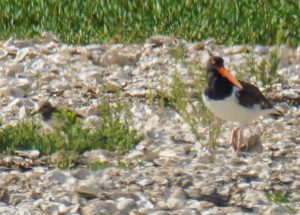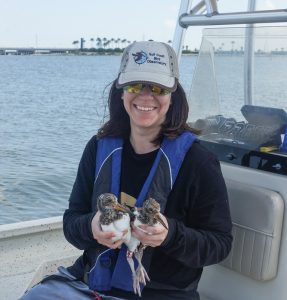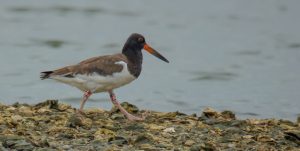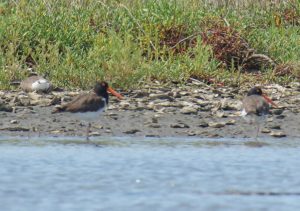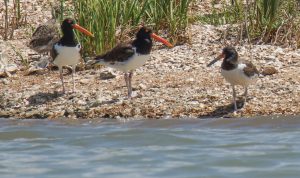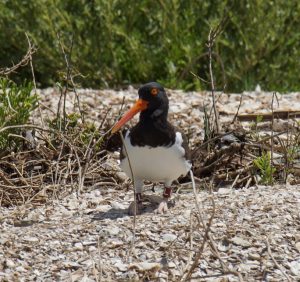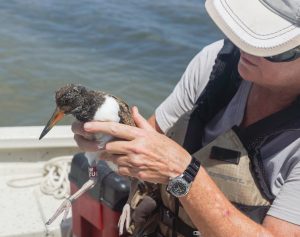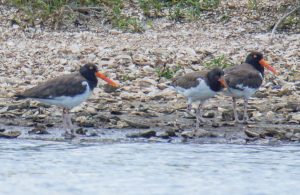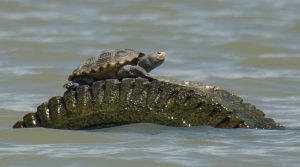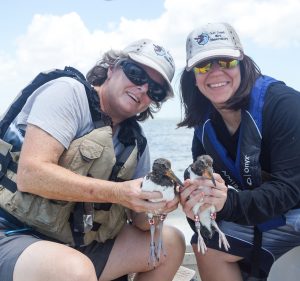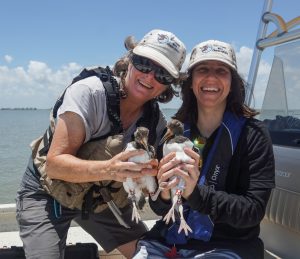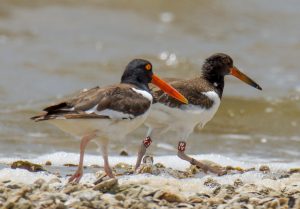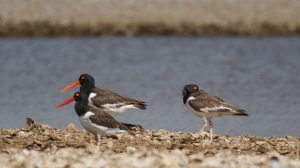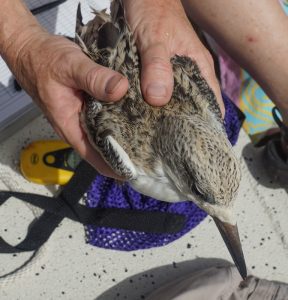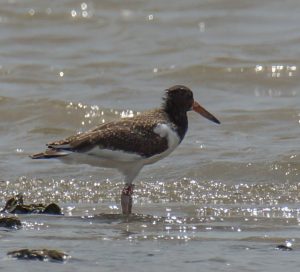By Susan Heath
On Tuesday I headed out to West Galveston Bay with Alan Wilde, John Wright and Emma Shelly. There were a lot of chicks to band so I invited Emma to join us to take advantage of her young legs! We headed up towards Swan Lake first thing. Not much happening up there anymore but we had a happy surprise when we confirmed that LR & unbanded have a chick from their nest that hatched last week.
We usually stop monitoring at the end of June but that chick means we will have to keep going out until the end of July. I’m always happy for more chicks so go LR & unbanded! Keep that little one safe. All the birds in Swan Lake were on the breakwaters again so they have definitely given up for the year.
Back down in West Galveston Bay we headed to Struve Luci to band 12 & unbanded’s chick. They had two chicks when the nest first hatched but last week we only saw one so we thought something had happened to the other one. Another happy surprise – they still had two! Fortunately when we landed to capture them for banding both of them laid down in the vegetation and we were able to get them easily. We banded them W0U and W3Y.
Nothing much happening with the other pairs there. U0U was hanging out with its parents (HM & X7).
We headed over to Jigsaw to check things out there. All three pairs were out on reefs so they all definitely failed. Bummer. Over on Galveston Island 16 & unbanded were hanging out on a reef with some early returning Long-billed Curlews along the shoreline.
Down at Gangs Bayou the pairs switched around a little bit. We found A5A with an unbanded bird on the breakwater where there used to be an unbanded pair. She was in this location last week too so she must have moved to another male or she and her mate ran off the unbanded pair that was previously in this location. To my thinking where they were before was better but I learned a long time ago that I don’t think like an oystercatcher! A1A and mate were also on the breakwater. A4A & unbanded and their chick W2W were hanging out along the shoreline. The chick was taking a little snooze and mooning us!
There was an unbanded pair farther down the breakwater so there are still four pairs there. There weren’t any oystercatchers on Confederate Reef so the gang must have found another place to hang out. On South Deer we found KK & unbanded with their chick very near where their nest had been.
LL was home alone and sitting in a position that seems quite awkward to me but must be comfortable because I’ve seen a lot of oystercatchers with their legs bent like this. Seems like a good time for an anatomy lesson. What most people think of as the knee in birds is actually the ankle which is why it bends backward. LL has his legs bent at the ankle. Bird’s knees are higher up the leg against the body and are hidden from view.
Next up was Y7 & unbanded’s chick which needed to be banded. When we approached we saw this.
When Emma and I ran after it, it ran up over a berm and hid. After a little searching we found it in the vegetation. We banded it W2U.
So far so good with the chicks. 13 & unbanded and their chick we banded last week (W2Y) were standing along their shoreline. Great news! Another fledged chick. The only other pair we found on South Deer was HL & L4 with their chick W3U.
We headed over to North Deer and found all the oystercatchers absent. I can’t say as I blame them. The place is overrun with young pelicans. It’s pretty hard to believe that 40 years ago it was difficult to find a pelican on the Upper Texas Coast. Although we didn’t see any oystercatchers we did see this beautiful female Diamond-backed Terrapin sunning itself on a tire. Good to know those old tires are good for something!
Marker 52 we found 23 & WY & their chick W0Y hanging out with the pelicans. H0 & JC were hanging out in their territory surrounded by pelicans also. We checked on ET & A8A and found ET on the island where their failed nest had been but there was no sign of A8A. She might have been on Marker 52 but we weren’t able to get a good enough photo to confirm that.
The last task of the day was to band the last two sets of chicks. Both P3 & unbanded and 28 & AP have two chicks this year. We did P3 & unbanded’s first. They nest on a tiny island and I was nervous about both catching them and letting them go. I like to approach an island so a chick has a long way to run because I don’t want them to get in the water and swim. They can swim very well and they can dive like a duck and they do it very effectively to avoid being caught. When chicks are on a small island giving them a long way to run isn’t an option. Emma and I jumped off the boat and made chase. The chicks weren’t quite sure what to do but at the last minute they both jumped into the water. Fortunately we were right there and were able to scoop them up with dip nets before they got away from us. Phew. We banded them W4U and W4W. When it was time to let them go, I took them over behind the tall vegetation in the center of the island and let them go there and then ran back around where they couldn’t see me. That worked pretty well and neither of them jumped back into the water. I am constantly have to figure out how outsmart these birds!
Last but not least was 28 & AP chicks. Giving them a long way to run wasn’t a problem on this island and one of them took full advantage! I was completely winded by the time I finally caught up to it and snagged it in the net. I think I’ll have to call that one Usain Bolt. We had thought something was wrong with the wing on one of these chicks last week but it seemed ok this week so we banded them W4X and W4Y and let them go. I had the release all planned so they could run over to their parents and be far enough away from us that they’d feel safe, but one of them didn’t get that memo and went the wrong way towards the water. We took the boat down to a reef in the direction it was swimming which caused it to turn around and head back to the nesting island. Phew again.
With that we were all done for the day.
On Friday I headed out to East Matagorda Bay with Alan Wilde and Keith Wise. We needed to check on all the chicks from last week and I was hoping to band some Black Skimmer chicks at a small colony at the Oyster Farm as part of our Black Skimmer Conservation Project. We checked on ER & unbanded and their chick W1Y first. This was the one that was a weak flyer last week which is what allowed us to catch it. All was well there!
At Old Gulf Cut we found that 17 & unbanded and their chick were not home. I had hoped to check out their chick because on Wednesday when I was out on Matagorda Peninsula helping with our Beach Nesting Birds Project I saw an unbanded oystercatcher chick that was limping. I was wondering if it was there’s but since they weren’t home, I wasn’t able to check.
On the other island there we hoped to find 25 & unbanded’s three chicks from last week that had ended up on a big island along the GIWW. They weren’t on the nesting island but we found two of them on the nest island over with both the adults. Where was the third chick? We looked all over the place but we didn’t find it. In the course of that another adult pair flew in and started having a territorial dispute with 25 & unbanded. Alan’s photos later revealed it was A7A & unbanded, a pair that I saw having a similar dispute with A6A & KN in another part of the bay. It will be interesting to see where they end up next breeding season!
We headed over to the Oyster Farm and found KM & unbanded with both their chicks on their island. These chicks fledged without getting banded so they will remain nameless unless they get caught as adults. The skimmers were here too. We parked the boat a ways away and then walked over to catch a few chicks. We managed to get nine with one pass but two were too small to band so we let them go. The other seven are now outfitted with a metal band and single color band with a three character code. Hopefully they will get reported somewhere and we’ll learn more about their movements around the Gulf.
The other island at the Oyster Farm is home to KT & unbanded and their three chicks that we banded last time. When we approached we saw the adults but only two chicks. Where’s the third chick again! We searched the island but we didn’t find it. The two that were there could fly now so I’m hoping the third one was just off on its own somewhere nearby. I wasn’t planning on going back out to this bay this year but I may need to so I can check on these chicks again.
We headed over to Dressing Point but the two pairs that had been hanging out in this area most of the season weren’t there now. One of the turtle volunteers saw one of these pairs on the beach on Wednesday but I don’t know where the other one is. The final pair to check on was A6A & KN. We found them feasting on one of their small islands but they flew out scolding us when we approached. Why do all these birds dislike me so much!
Since we had to go right by ER & unbanded and their chick on the way back we checked on them again. They were all doing just fine and we saw the chick make a short flight from one end of the island to the other. It’s always good to see them fly.
Current Stats for upper Texas coast from Dickinson Bay to East Matagorda Bay: 0 nests being incubated, 58 failed nests, 5 nests with unfledged chicks, 0 nests with undetermined status, 23 chicks fledged
This project is supported by the National Fish and Wildlife Foundation and several private donors. If you would like to contribute you can do that on our website by clicking here! All donations are tax deductible and GREATLY appreciated.
Note: All trapping and banding for this project is in accordance with federal and state permits issued to Susan Heath, GCBO Director of Conservation Research. Bird handling by volunteers is only permitted in the presence of Susan Heath and volunteers are trained in proper bird handling techniques.

